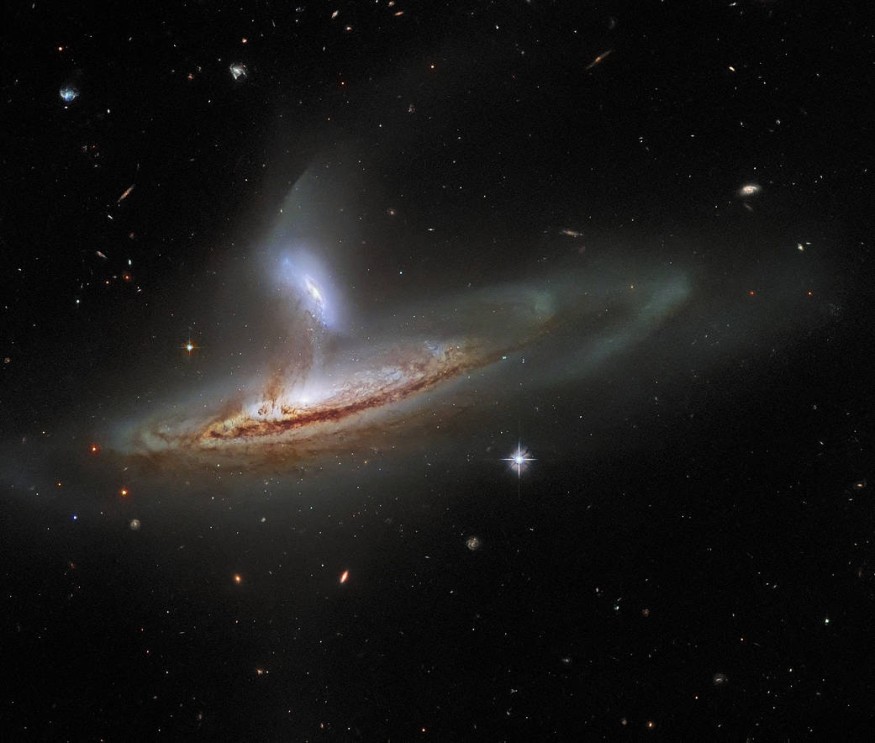NASA's Hubble Space Telescope discovered an unusual picture of two galaxies seeming to 'dance' with one another in an interaction called Arp 282. A tiny galaxy, IC 1559 (also known as Syfert Galaxy), attracts cosmic material from this giant galaxy, NGC169.
Many comparably active galaxies are difficult to view because they emit radiation. Still, Digital Trends said Seyfert galaxies emit energy at wavelengths that are not visible to Hubble's equipment. This implies that, despite its high activity, the galaxy might be easily seen.
📷 This NASA/ESA @HUBBLE_space Telescope image shows Arp 282, an interacting galaxy pair composed of galaxies NGC 169 (bottom) and IC 1559 (top) 👉 https://t.co/Qf1fSjmZG2 pic.twitter.com/hjRsr32N4C
— European Space Agency (@esa) February 7, 2022
NASA Hubble Space Telescope Sees Weird Galaxy Dancing With One Another
Our cosmic eye has been the Hubble Space Telescope, orbiting the Earth for three decades. It has been able to view objects from such a great distance that it is difficult to believe.
This is another object discovered by NASA's and the European Space Agency's (ESA) instrument. This is what enables us to comprehend the evolution of a galaxy.
According to NASA, the way galaxies interact is now regarded as a key component of evolving. When two galaxies collide, their forms and structures shift.
This is because galaxies may merge, collide, or brush against one another. Even though these interactions are widespread, getting an image of two galaxies interacting in this manner is very uncommon.

Galaxy As Explained by NASA
ESA said when two galaxies collide, a lot of gas, dust, and possibly whole solar systems will be dragged away from one galaxy and toward the other. The reason for this is due to tidal forces. Little streams of matter join the two galaxies in this image, demonstrating how this process works.
Tidal forces occur when the gravity of one thing causes another object to deform or stretch. In this situation, the tidal forces will shift away from the low-mass item and toward the high-mass object.
A galaxy is a collection of stars, dust, gas, and dark matter that travels in the same direction and is kept together by gravity. The number of stars in a galaxy might range from a few hundred million to a hundred trillion.
The gravitational attraction of their mass holds them together. A tiny dwarf galaxy may have a few million stars. In contrast, the largest known galaxies may have up to a hundred trillion stars, making them very massive.
Hubble Continues to Send Fascinating Things
Even after all the years that astronomers have spent studying the sky above, there are still aspects of the cosmos that fascinate them. Strange new planets are found, strange universes emerge, and the hunt for fresh wonders is never-ending.
Screen Rant said that NASA's Hubble Space Telescope is responsible for many of these breakthroughs. Even though it isn't the most recent space sensor, Hubble continues to play an important function in the business. It has aided scientists in determining the age of the cosmos, revealing important details about our Solar System, and uncovering incredible galaxies millions of light-years distant from Earth.
While interacting galaxies are frequent in space, NASA claims that "capturing a photograph of two galaxies interacting in such an obviously dynamic fashion" is uncommon. And it's for this reason why Hubble is still such an essential instrument. It may not be the most sophisticated telescope in 2022, but it may nevertheless provide incredible images that might otherwise go unnoticed.
Check out more news and information on Space in Science Times.
© 2025 ScienceTimes.com All rights reserved. Do not reproduce without permission. The window to the world of Science Times.












